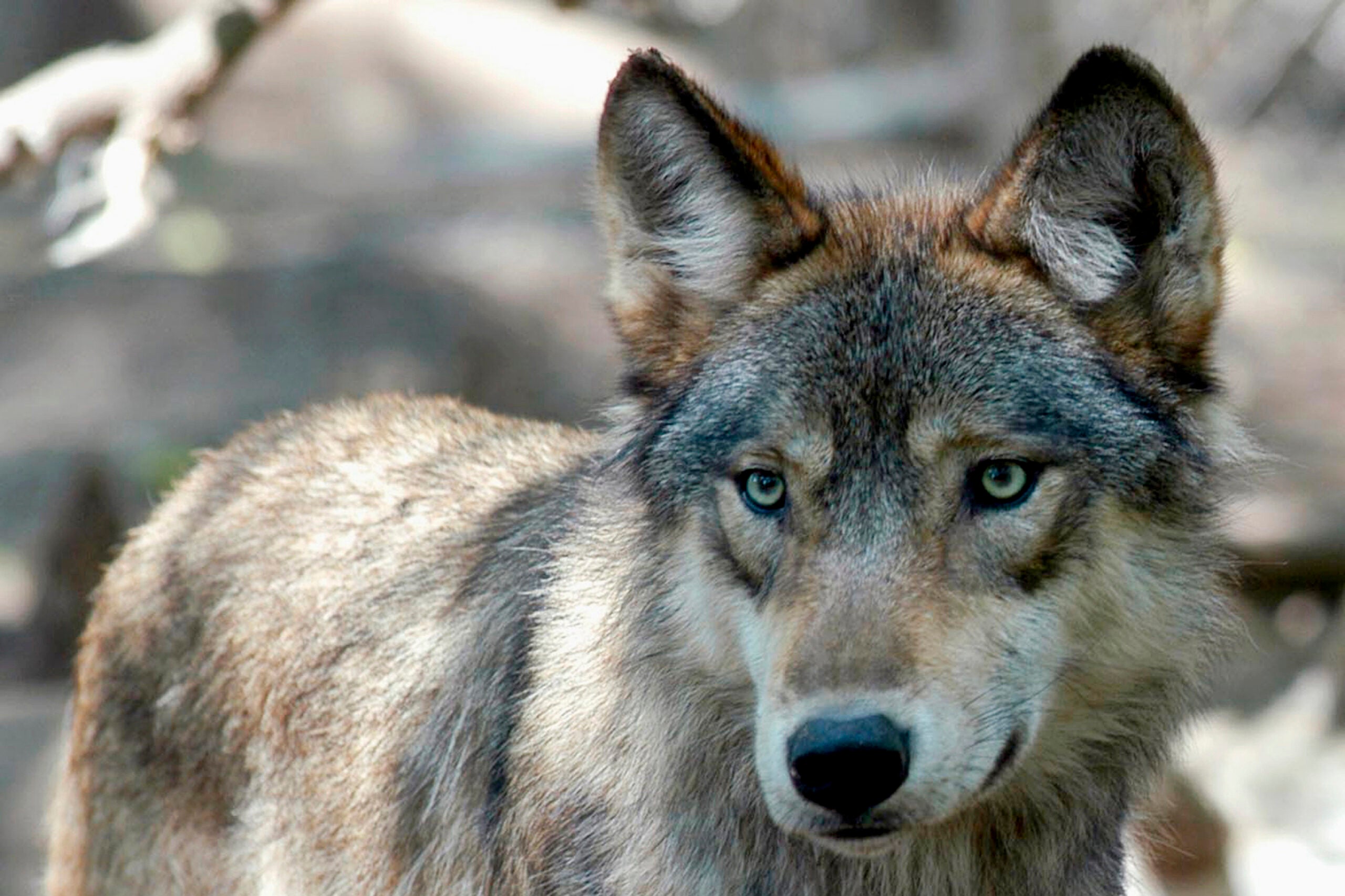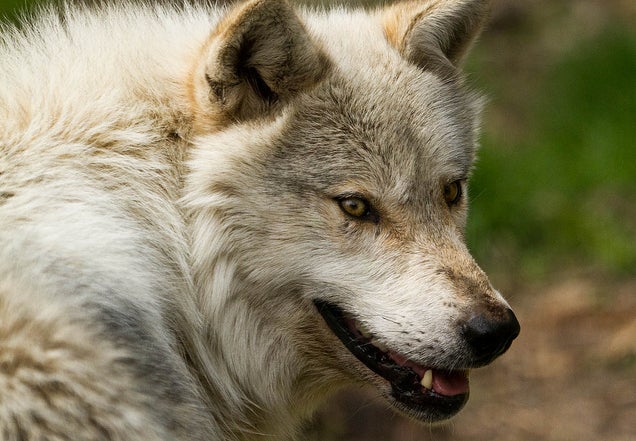Hunters killed nearly 100 more wolves than allowed under quota as part of the state’s first wolf hunt this week in six years.
State-licensed hunters reported 216 wolves were harvested as of 3 p.m. Thursday after the Wisconsin Department of Natural Resources closed the abbreviated wolf season Wednesday. That’s around 82 percent more than the 119 wolves they were allowed to take after splitting a 200-wolf quota with Wisconsin tribes.
In a media briefing Thursday, the DNR reported the vast majority of wolves — 86 percent — were taken with hounds and 5 percent were harvested by trappers. Nine percent of wolves were harvested by other methods. Wisconsin is the only state that allows using dogs to hunt wolves.
Stay informed on the latest news
Sign up for WPR’s email newsletter.
The DNR reported 54 percent of wolves harvested were male while 46 percent were female. This is the first wolf hunt to take place in the middle of the wolf’s breeding season, sparking concerns about the impact of the hunt on the wolf population.
When asked why the DNR didn’t act to close the season sooner, officials said they were checking the harvest by the hour. But, Eric Lobner, director of the DNR’s wildlife management bureau, said their hands were tied by a requirement to provide 24-hour notification to hunters under state law.
“But, certainly, looking at … how far we went over our goal was not necessarily our objective here for sure, and so we’re going to be monitoring that very closely,” said Lobner.
Nearly 2,400 wolf permits were available to hunters during the shortened wolf season, and Lobner said the sheer number of tags awarded made it difficult to manage and meet the state’s harvest goal. The agency awarded more than 1,400 permits for this week’s hunt.
The wolf season was held against the DNR’s recommendation that the hunt resume in November. The agency’s decision to hold off on a hunt this winter drew backlash from Republican lawmakers and hunters, resulting in a lawsuit filed by a conservative advocacy group on behalf of Kansas-based Hunter Nation.
The group sought a court order to force the DNR to resume the hunt, and a Jefferson County judge sided with the hunting organization earlier this month. The agency asked an appeals court to put that ruling on hold, but a panel of judges dismissed the DNR’s appeal last week.
DNR Large Carnivore Specialist Randy Johnson said the wolf population is resilient, and Wisconsin’s segment is part of a much larger population that’s connected to surrounding states. Johnson said there has been uncertainty over whether the wolf population would decline or expand in response to the agency’s recommended quota, noting that hunters went over the total allowable harvest by a “small percentage.”
“I would say there’s low concern at the population level of any significant effects there,” said Johnson.
The total number of animals harvested could reach as high as nearly 300 wolves if Ojibwe tribes used the 81 wolf permits allocated to them under the state’s quota. However, that’s unlikely as tribes have viewed Ma’iingan — the Anishinaabe word for wolf — as relatives that are revered.
Hunters feared this may be there only chance to harvest wolves if protections for the animal are restored under President Joe Biden. He issued a broad executive order in January to review agency rules, including the wolf’s delisting. Environmental and wildlife groups have also sued to reverse the Trump administration’s decision to delist the wolf across most of the country.
P.J. Foat, of Barnes, got a wolf permit for the shortened season. He went out along with friends that were hunting with hounds in Bayfield and Douglas counties. Foat said he wasn’t successful, but his friends were able to harvest wolves.
Foat thinks the fact that hunters were able to harvest the quota in just several days is proof of how much the population has grown.
“There’s way more wolves than anybody thinks there are,” said Foat. “They’re too hard to hunt to be that successful.”
He said hunters feel it’s their duty to scale the population back to support a habitat where all animals can thrive. They’ve also argued hunters have a right to hunt wolves in Wisconsin under the law.
The DNR is required to hold a single season from Oct. 15 through February when the animal isn’t listed as an endangered species. Hunters along with farmers point to livestock and pets that have been killed by wolves as their population had grown to nearly 1,200 wolves prior to the hunt.
Opponents of the wolf hunt say the DNR was rushed to hold a hunt that was not based on sound science. Environmental and animal rights groups along with Wisconsin tribes have argued the state’s wolf management plan, which set a goal of 350 wolves, is vastly outdated.
They also highlight the hunt was organized without adequate public input and consultation from tribes as part of federal treaty rights that were affirmed in a 1983 federal court ruling known as the Voigt Decision.
“This is a clear example of mismanagement and full disrespect to Wisconsin tribal nations with treaty protected rights,” said Dylan Jennings, spokesperson for the Great Lakes Indian, Fish and Wildlife Commission. “The decisions neglected science, and tribes have always adhered to their tribal quotas, and they fully expected the state to do the same. And, so, it’s a major disappointment. We could be looking at major implications for Wisconsin wolf packs for years to come.”
Jennings said the state’s lack of consultation and enforceable management are red flags that would likely be discussed between the DNR and tribes moving forward. He declined to comment on whether tribes had used any of the wolf permits they were allocated.
Megan Nicholson, Wisconsin state director for the Humane Society of the United States, said in a statement that this has been a sad and shameful week for Wisconsin.
“Trophy hunters and trappers drastically blew past the quota of 119 and killed over 200 wolves, using the most egregious methods imaginable and during the breeding season when wolves are pregnant,” said Nicholson. “Entire wolf families were likely destroyed during this intense slaughter, highlighting how crucial it is that wolf management in Wisconsin immediately change before this heartbreaking situation repeats itself in November.”
She wants groups like the Humane Society and others to have a seat at the table as the state moves forward with updating its wolf management plan and setting a quota for the next wolf hunt.
Hunters can already begin applying for the Nov. 6 wolf hunt Monday. The agency is forming a wolf advisory committee to help develop quota recommendations the fall wolf season. Discussion and consultation with the state’s tribes about the next wolf quota would begin after population surveys of the animal end in April. The DNR plans to bring a quota before the board for approval in August.
Wisconsin Public Radio, © Copyright 2024, Board of Regents of the University of Wisconsin System and Wisconsin Educational Communications Board.



